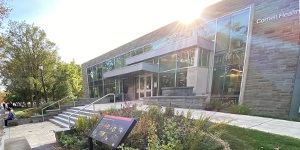Our products
The pharmacy at Cornell Health provides a variety of herbal products to support your well-being, including:
- Local herbal tea blends to support health:
- Green, black, and oolong teas
- Herbal extracts and nutritional supplements
- Honey
Products sold in our pharmacy are selected based on careful review of available research and obtained from high-quality sources, including local certified farms when possible. Learn more about our herbal pharmacy products.
Support for herbal therapeutics and nutritional supplements
If you have questions about whether herbal products may be right for you — including whether they may interfere with other medications or conditions — please talk with our pharmacy staff, a CAPS provider, or with your primary care provider (PCP). These staff members can also consult directly with our specialist about herbs and nutritional supplements for students.
Kara Timmins PA-C, CHT is our staff resource for herbal therapeutics and has developed these local herbal tea blends in collaboration with Healing Spirits Herb Farm and student support. She is available for consultation at Cornell Health or during plant medicine educational opportunities on campus.
About herbal medicine
It is estimated that up to four billion people (representing 80% of the world's population) living in the world today rely on herbal medicinal products as a primary source of healthcare. The World Health Organization estimates 88% of all countries use traditional medicine such as herbal medicine.
- The first written record of medicinal plants was created on clay tablets over 5000 years ago by the Sumerians, in ancient Mesopotamia (Iraq).
- Around 1500 BCE the Ancient Egyptians wrote the Ebers Papyrus which listed over 850 herbal medicines. This compilation includes many herbs we recognize and use today (e.g., thyme, basil, elderberry, honey).
- Traditional Chinese and Asian Medicine systems have been documented for over 2000 years, with oral traditions dating back to the first Chinese herbalist, said to be Shennong in 28th century BCE.
- Ayurvedic medicine traditions have been documented in the Charaka Samhita believed to have arisen around 400-200 BCE.
- Western herbalism was first documented in Europe during the 1st century BCE.
- Many Indigenous plant medicine traditions have been passed down through thousands of years and generations are still practiced today.
Herbal terminology
- Nutritive: are a class of herbs that are rich in vitamins and minerals; providing a source of easily assimilated nutrients to aid in the body’s innate function and hemostasis. Some locally grown nutritive herbs include:
- Alfalfa leaf (Medicago farfara)
- Nettles leaf (Urtica dioica)
- Oatstraw or Oat Tops (Avena sativa)
- Thyme (Thymus vulgaris)
- Raspberry Leaf (Rubus idaeus)
- Mullein leaf (Verbascum thapsus)
- Rose petals (Rosa ssp)
- Hawthorn berry (Crategus sp)
- Elderberry and Elderflower (Sambucus nigra)
- Yarrow leaf (Achillea millefolium)
- Spearmint leaf (Mentha spicata)
- Fennel seed (Foeniculum vulgare)
- Anise Hyssop (Agastache foeniculum)
- Goldenrod (Solidago sp)
- Adaptogenic Herbs (Adaptogens): nontoxic herb purported to increase the body's ability to resist the damaging effects of stress and promote or restore normal physiological functioning. They have been used in Traditional Chinese and Ayurvedic medicines for centuries to promote a sense of well-being. They may provide a sustained sense of calm, and while they increase energy. Locally grown adaptogens include:
- Holy Basil (Ocimum sanctum)
- Ashwagandha (Withania somniferum)
- American Ginseng (Panax quinquefolius)
- Lion’s mane (Hericium erinaceus)
- Nervine Herbs: support the nervous system by effects on neurotransmitters and nerve tissue and/ or providing minerals, amino acids and b-vitamins essential for nervous system function. Three categories: calming, stimulating, and modulating (nutritive herbs). Locally grown nervines:
- Lavender flowers (Lavandula ssp)
- Lemon Balm (Melissa officinalis)
- St. John’s Wort (Hypericum perforatum)
- Lion’s Mane (Hericium erinaceus)
- Common Sage leaf (Salvia officinalis)
- Gingko leaf (Ginkgo biloba)
Herbal constituents
- Flavonoids: a group of polyphenolic compounds found abundantly in plants. While their benefits are under ongoing research, they are showing effects such as anti-oxidative, anti-inflammatory, anti-mutagenic and anti-carcinogenic properties coupled with their capacity to modulate key cellular enzyme function.
- Essential (Volatile) Oils: mixtures of fragrant compounds; most of the evidence shows antimicrobial activity, antispasmodic activity, nervous system support, and carminative action to help dispel intestinal gas.
Plants are complex organisms with numerous constituents all contributing to their matrix. More research is needed to unmask the intricacies and their interactions within the human body. The above constituents are abundant in many of the nutritive and adaptogenic herbs.
Effectiveness
The following sources are considered when evaluating the effectiveness of herbal products:
- Ethnobotanical information
- Traditional and historical uses and data
- Expert opinion: consensus based on observation
- Scientific evidence:
- Biochemical studies, including analysis of herbal constituents
- In vitro studies (in lab)
- In vivo studies (in animal research, case studies, randomized single and double blinded controlled trials)
- Meta-analysis and reviews
Trusted links...
- Examine.com
- Memorial Sloan Kettering Cancer Center’s “About Herbs”
- National Center for Complementary and Integrative Health’s “Herbal Supplements”
- TRC Healthcare Database (Formerly Natural Medicines’ Database)
- UptoDate.com
- WHO Global Centre for Traditional Medicine
Print resources
- Ganora, Lisa. (2009). Herbal constituents: foundations of phytochemistry: a holistic approach. Colo: Herbalchem Press.
- Grieve, M. (Maud). (1931). A modern herbal; the medicinal, culinary, cosmetic and economic properties, cultivation and folk-lore of herbs, grasses, fungi, shrubs, & trees with all their modern scientific uses. New York :Harcourt, Brace & company.
- Mills, S and Bone, K. Principles and Practice of Phytotherapy : Modern Herbal Medicine. Churchill Livingstone; 2000. (copy available through Cornell University library system)


